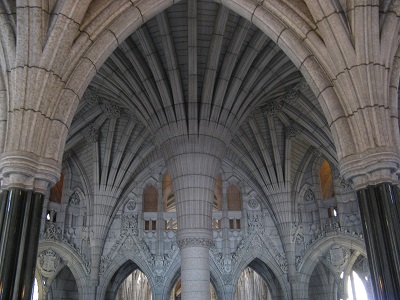Parliament Hill, Centre Block
Classified Federal Heritage Building
Ottawa, Ontario

Interior view
© Parks Canada | Parcs Canada
Address :
111 Wellington Street, Parliament Complex, Ottawa, Ontario
Recognition Statute:
Treasury Board Policy on Management of Real Property
Designation Date:
1987-05-27
Dates:
-
1916 to 1927
(Construction)
Event, Person, Organization:
-
John Pearson
(Architect)
-
J. Omar Marchand
(Architect)
Custodian:
Public Works and Government Services Canada
FHBRO Report Reference:
86-52
DFRP Number:
08834 00
Description of Historic Place
Housing the Senate and the House of Commons, the Centre Block in the Parliament Complex is an ordered, monumental building constructed in Nepean sandstone with copper roofing. Designed in a Gothic revival style, the clearly articulated exterior, with its grand public entrance through the soaring Peace Tower, and flanking entrances to the House of Commons and Senate Chambers, reflects a rational and well-ordered interior plan. The designation is confined to the footprint of the building.
Heritage Value
The Centre Block was designated as a Classified Federal Heritage Building because of its exceptional significance as a national landmark, and because of the ceremonial and iconographic design and detailing of the building itself. As the site since 1922 of both the House of Commons and the Senate, it has come to symbolize Canada's nationhood.
Sources:
Robert Hunter, Parliament Hill Complex, Ottawa, Ontario, Federal Heritage Building Review Office Building Report 86-052; Parliament Hill Complex, Ottawa, Ontario, Heritage Character Statement, 86-052.
Character-Defining Elements
Key elements that define the heritage value of the site include: its conception as a symbol of Canada; the whole of its exterior, centred on the Peace Tower; its many public interiors and its ceremonial circulation spaces, which are inextricably entwined with its symbolic and practical functions as the seat of government, and thus embody its heritage character; its function as an example of the design methodology of the École des Beaux Arts applied to a Gothic design vocabulary; its clear functional layout reinforced by a carefully considered hierarchy of space; the Gothic ornament of the building, which does not aspire to a 19th century
picturesqueness, and which is carefully worked out to reinforce the clear reading of the building and its hierarchy of space; the on-going carving program in the building, which has become a small part of its heritage character (the original design of the building made ample provision for continuing decoration, which has generally taken the form of commemorative devices).
Heritage Character Statement
Disclaimer -
The heritage character statement was developed by FHBRO to explain the reasons for the designation of a federal heritage building and what it is about the building that makes it significant (the heritage character). It is a key reference document for anyone involved in planning interventions to federal heritage buildings and is used by FHBRO in their review of interventions.
The Centre Block was built during the period 1916-1927 to the designs of John A. Pearson, architect and J.O. Marchand, associate architect. It replaced the original Centre Block (1859-1865 Thomas Fuller and Chilion Jones) destroyed by fire in 1916. It is under the care of Public Works Canada. See FHBRO Building Report 86-52.
Reason for Designation
On January 16, 1986, the Centre Block was designated Classified because of its exceptional significance as a national landmark. It has come to symbolize Canada's nationhood, not only because of its historical associations as the site since 1922 of both the House of Commons and the Senate, but also because of the ceremonial and iconographic design and detailing of the building itself.
Character Defining Elements
The Centre Block was consciously designed as a symbol of Canada. The whole of its exterior, centred on the Peace Tower, its many public interiors and its ceremonial circulation spaces are inextricably entwined with its symbolic and practical functions as the seat of government, and thus embody its heritage character.
The Centre Block is an example of the design methodology of the Ecole des Beaux Arts applied to a Gothic design vocabulary. Its character derives from the relationship between Beaux Arts and Gothic. The Beaux Art method gave the building its symmetry of plan and composition and its clear functional layout reinforced by a carefully considered hierarchy of space. Beaux Arts regularity infuses the building; it is essential to the order and formality that form a large part of its heritage character.
The Gothic ornament of the building has an important symbolic value. This is a very regularized Gothic; it does not aspire to a 19th century picturesqueness. The ornamental scheme is carefully worked out to reinforce the clear reading of the building and its hierarchy of space. A thorough understanding of this ornamental system is fundamental to the appropriate care of the building.
The on-going carving program in the building has become a small part of its heritage character. In this and other decorative work -- and a distinction must be drawn between ornament and decoration -- some stylistic evolution is to be expected. The original design of the building made ample provision for continuing decoration, which has generally to date taken the form of commemorative devices. It is important that decoration not be allowed to obscure the architectural clarity of the building.
The Centre Block was reglazed some years ago. This work is noticeably badly detailed.